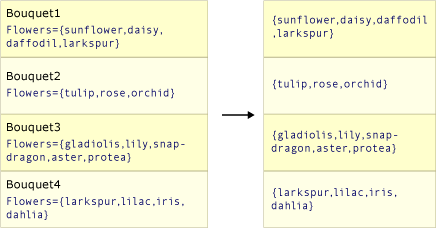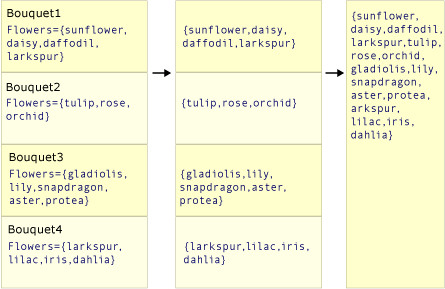投影运算 (Visual Basic)
投影是指将对象转换为一种新形式的操作,该形式通常只包含那些将随后使用的属性。 通过使用投影,您可以构造从每个对象生成的新类型。 可以投影属性,并对该属性执行数学函数。 还可以在不更改原始对象的情况下投影该对象。
下面一节列出了执行投影的标准查询运算符方法。
方法
| 方法名 | 描述 | Visual Basic 查询表达式语法 | 更多信息 |
|---|---|---|---|
| 选择 | 投影基于转换函数的值。 | Select |
Enumerable.Select Queryable.Select |
| SelectMany | 投影基于转换函数的值序列,然后将它们展平为一个序列。 | 使用多个 From 子句 |
Enumerable.SelectMany Queryable.SelectMany |
| Zip | 使用 2-3 个指定序列中的元素生成元组序列。 | 不适用。 | Enumerable.Zip Queryable.Zip |
查询表达式语法示例
选择
下面的示例使用 Select 子句来投影字符串列表中每个字符串的第一个字母。
Dim words = New List(Of String) From {"an", "apple", "a", "day"}
Dim query = From word In words
Select word.Substring(0, 1)
Dim sb As New System.Text.StringBuilder()
For Each letter As String In query
sb.AppendLine(letter)
Next
' Display the output.
MsgBox(sb.ToString())
' This code produces the following output:
' a
' a
' a
' d
SelectMany
下面的示例使用多个 From 子句来投影字符串列表中每个字符串中的每个单词。
Dim phrases = New List(Of String) From {"an apple a day", "the quick brown fox"}
Dim query = From phrase In phrases
From word In phrase.Split(" "c)
Select word
Dim sb As New System.Text.StringBuilder()
For Each str As String In query
sb.AppendLine(str)
Next
' Display the output.
MsgBox(sb.ToString())
' This code produces the following output:
' an
' apple
' a
' day
' the
' quick
' brown
' fox
Select 与 SelectMany
Select() 和 SelectMany() 的工作都是依据源值生成一个或多个结果值。 Select() 为每个源值生成一个结果值。 因此,总体结果是一个与源集合具有相同元素数目的集合。 与之相反,SelectMany() 生成单个总体结果,其中包含来自每个源值的串联子集合。 作为参数传递到 SelectMany() 的转换函数必须为每个源值返回一个可枚举值序列。 然后,SelectMany() 串联这些可枚举序列,以创建一个大的序列。
下面两个插图演示了这两个方法的操作之间的概念性区别。 在每种情况下,假定选择器(转换)函数从每个源值中选择一个由花卉数据组成的数组。
下图描述 Select() 如何返回一个与源集合具有相同元素数目的集合。

下图描述 SelectMany() 如何将中间数组序列串联为一个最终结果值,其中包含每个中间数组中的每个值。

代码示例
下面的示例比较 Select() 和 SelectMany() 的行为。 代码通过从源集合的每个花卉名称列表中提取项来创建一个“花束”。 此示例中,transform 函数 Select<TSource,TResult>(IEnumerable<TSource>, Func<TSource,TResult>) 使用的“单值”本身即是值的集合。 这需要额外的 For Each 循环,以便枚举每个子序列中的每个字符串。
Class Bouquet
Public Flowers As List(Of String)
End Class
Sub SelectVsSelectMany()
Dim bouquets = New List(Of Bouquet) From {
New Bouquet With {.Flowers = New List(Of String)(New String() {"sunflower", "daisy", "daffodil", "larkspur"})},
New Bouquet With {.Flowers = New List(Of String)(New String() {"tulip", "rose", "orchid"})},
New Bouquet With {.Flowers = New List(Of String)(New String() {"gladiolis", "lily", "snapdragon", "aster", "protea"})},
New Bouquet With {.Flowers = New List(Of String)(New String() {"larkspur", "lilac", "iris", "dahlia"})}}
Dim output As New System.Text.StringBuilder
' Select()
Dim query1 = bouquets.Select(Function(b) b.Flowers)
output.AppendLine("Using Select():")
For Each flowerList In query1
For Each str As String In flowerList
output.AppendLine(str)
Next
Next
' SelectMany()
Dim query2 = bouquets.SelectMany(Function(b) b.Flowers)
output.AppendLine(vbCrLf & "Using SelectMany():")
For Each str As String In query2
output.AppendLine(str)
Next
' Display the output
MsgBox(output.ToString())
' This code produces the following output:
'
' Using Select():
' sunflower
' daisy
' daffodil
' larkspur
' tulip
' rose
' orchid
' gladiolis
' lily
' snapdragon
' aster
' protea
' larkspur
' lilac
' iris
' dahlia
' Using SelectMany()
' sunflower
' daisy
' daffodil
' larkspur
' tulip
' rose
' orchid
' gladiolis
' lily
' snapdragon
' aster
' protea
' larkspur
' lilac
' iris
' dahlia
End Sub
